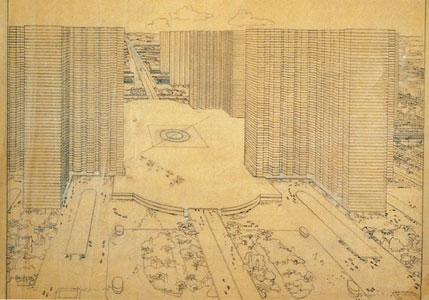|

Which takes us to Charles Edouard
Jeanneret, better known as Le Corbusier (1887-1965). He was a
Swiss-French architect who played a decisive role in the development
of modern architecture. In 1908, Le Corbusier went to work with
Auguste Perret, the French architect who had pioneered the use of
reinforced concrete. In 1910 he worked for several months in the
Berlin studio of architect and ‘industrial’ designer Peter Behrens,
where he met the future Bauhaus leaders Ludwig Mies van der Rohe and
Walter Gropius. Unlike Antonio Sant’Elia he survived the First World
War and turned to the avant-garde full time, becoming a painter,
pamphleteer, architect and urban planner.
Having published a
series of polemical essays in the journal L’Esprit Noveau
which he published with Cubist painter Amédée Ozenfant, Jeanneret
published them together in a book entitled Towards a New
Architecture (Vers une architecture) under the nom de
plume Le Corbusier in 1923. It is from this book that the famous
quote “A house is a machine for living in” is drawn.
In this
collection, Le Corbusier set out his theory for architecture that
would be true to its time, a product of its own Modern age rather
than indebted to classical or Renaissance forms.
In the
1920s and '30s, Le Corbusier's most significant work was in urban
planning. In 1922 he published his detailed plan for a New City for Three Million People
(La Ville Contemporaine), a ruthlessly planned city where
there was a place for everything and everything was in its place.
Twenty four large cruciform-shaped glass towers in the centre
formed the commercial district set in a central parkland, surrounded
by industrial and residential quarters. Furthest away of all
was the sports stadium. 
In 1925 Le Corbusier proposed
the Plan Voisin de Paris which would have involved
demolishing practically all on the north bank of the Seine to build
a smaller version of the Ville Contemporaine. Presumably this
kind offer was turned down by philistine civil servants comfortably
ensconced in the Louvre complex at the time.
Both La Ville
Contemporaine and Le Plan Voisin de Paris incorporated
airports at the heart of their plans - Voisin is actually a
reference to the French aircraft manufacturer of the same
name. Unlike Sant'Elia's visionary depiction however, Le
Corbusier didn't give these airports room to breathe let alone room
to grow. As can be seen from the depiction at left taken from
Le Plan Voisin de Paris, the airfield may be geographically
at the heart of Le Corbusier's vision but at the periphery of his
vision. Aircraft and tall buildings do not make comfortable
neighbours, for either pilots or residents. Noise, danger of
collision, treacherous airflows in the lee of the towers, no room
for growth or expansion - there are many reasons why this
concept is unworkable.
Despite Le Corbusier's
position as poster child for modern architecture, I find it hard to
warm to his philosophy. Looking at the overall plans
for his fantasy city, one is struck by the level of directed
neatness - it is designed symmetrically and will remain symmetrical
regardless of the wishes of the inhabitants. It is mechanistic
not organic. The residents must fit into the structure of the
city, there is no question of the city adapting around the needs of
its residents. The sports stadium sits to one side of the
plan, some ways off from the population centre. It might as
well be in the neighbouring town for all the relevance accorded it
by Le Corbusier.
Le Corbusier went on to
publish a number of other urban plans before drifting into an
espousal of ‘New Brutalism’ a school of architecture which espoused
weather-stained exposed concrete beam which had the primary
advantage of being really, really cheap to build because finishing
and cladding weren’t deemed necessary. It was buildings of
this sort that gave Coventry its distinctive look. With such
bad progeny, the Modernist movement finally expired in the new town
tower blocks of the 1950s and 1960s, unmourned by the people
de-humanised by having to live among its unfeeling and unsympathetic
creations..
| 
